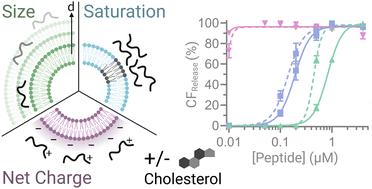Influence of lipid vesicle properties on the function of conjugation dependent membrane active peptides
IF 6.1
3区 医学
Q1 MATERIALS SCIENCE, BIOMATERIALS
引用次数: 0
Abstract
Membrane active peptides (MAPs) can provide novel means to trigger the release of liposome encapsulated drugs to improve the efficacy of liposomal drug delivery systems. Design of MAP-based release strategies requires possibilities to carefully tailor the interactions between the peptides and the lipid bilayer. Here we explore the influence of lipid vesicle properties on the function of conjugation-dependent MAPs, specifically focusing on two de novo designed peptides, JR2KC and CKV4. Utilizing liposomes with differences in size, lipid composition, and surface charge, we investigated the mechanisms and abilities of the peptides to induce controlled release of encapsulated cargo. Our findings indicate that liposome size modestly affects the structural changes and function of the peptides, with larger vesicles facilitating a minor increase in drug release efficiency due to higher peptide-to-liposome ratios. Notably, the introduction of negatively charged lipids significantly enhanced the release efficiency, predominantly through electrostatic interactions that favor peptide accumulation at the lipid bilayer interface and subsequent membrane disruption. The incorporation of cholesterol and a mix of saturated and unsaturated lipids was shown to alter the vesicle's phase behavior, thus modulating the membrane activity of the peptides. This was particularly evident in the cholesterol-enriched liposomes, where JR2KC induced lipid phase separation, markedly enhancing cargo release. Our results underscore the critical role of lipid vesicle composition in the design of MAP-based drug delivery systems, suggesting that precise tuning of lipid characteristics can significantly influence their performance.

脂质囊泡特性对共轭依赖性膜活性肽功能的影响
膜活性肽(MAPs)可以为触发脂质体包裹药物的释放提供新的手段,从而提高脂质体给药系统的疗效。设计基于 MAP 的释放策略需要仔细调整肽与脂质双分子层之间的相互作用。在此,我们探讨了脂质囊特性对共轭依赖性 MAP 功能的影响,特别关注两种全新设计的肽--JR2KC 和 CKV4。利用大小、脂质成分和表面电荷不同的脂质体,我们研究了多肽诱导包囊货物控制释放的机制和能力。我们的研究结果表明,脂质体的大小会适度影响多肽的结构变化和功能,由于多肽与脂质体的比率较高,较大的囊泡可略微提高药物释放效率。值得注意的是,引入带负电荷的脂质可显著提高释放效率,这主要是通过静电相互作用,有利于多肽在脂质双分子层界面聚集,并随后破坏膜。胆固醇和饱和与不饱和脂质的混合加入改变了囊泡的相行为,从而调节了多肽的膜活性。这一点在富含胆固醇的脂质体中尤为明显,JR2KC 在这种脂质体中诱导了脂相分离,从而显著促进了货物的释放。我们的研究结果凸显了脂质囊泡组成在设计基于 MAP 的药物递送系统中的关键作用,表明对脂质特性的精确调节可显著影响药物递送系统的性能。
本文章由计算机程序翻译,如有差异,请以英文原文为准。
求助全文
约1分钟内获得全文
求助全文
来源期刊

Journal of Materials Chemistry B
MATERIALS SCIENCE, BIOMATERIALS-
CiteScore
11.50
自引率
4.30%
发文量
866
期刊介绍:
Journal of Materials Chemistry A, B & C cover high quality studies across all fields of materials chemistry. The journals focus on those theoretical or experimental studies that report new understanding, applications, properties and synthesis of materials. Journal of Materials Chemistry A, B & C are separated by the intended application of the material studied. Broadly, applications in energy and sustainability are of interest to Journal of Materials Chemistry A, applications in biology and medicine are of interest to Journal of Materials Chemistry B, and applications in optical, magnetic and electronic devices are of interest to Journal of Materials Chemistry C.Journal of Materials Chemistry B is a Transformative Journal and Plan S compliant. Example topic areas within the scope of Journal of Materials Chemistry B are listed below. This list is neither exhaustive nor exclusive:
Antifouling coatings
Biocompatible materials
Bioelectronics
Bioimaging
Biomimetics
Biomineralisation
Bionics
Biosensors
Diagnostics
Drug delivery
Gene delivery
Immunobiology
Nanomedicine
Regenerative medicine & Tissue engineering
Scaffolds
Soft robotics
Stem cells
Therapeutic devices
 求助内容:
求助内容: 应助结果提醒方式:
应助结果提醒方式:


